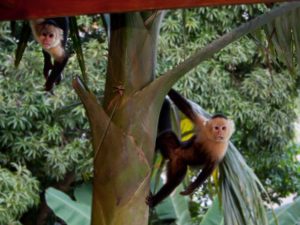Fauna in Manuel Antonio national park
Along the Pacific coast of Costa Rica, the fauna of Manuel Antonio National Park stands as a beacon of biodiversity and natural splendor. Covering an area of just 16.7 square kilometers (6.5 square miles), this small but incredibly diverse park is a testament to the rich tapestry of life that thrives within its borders. From lush rainforests to pristine beaches, Manuel Antonio is a haven for both nature enthusiasts and wildlife lovers. Join us on an exhilarating journey as we delve into the captivating world of animals that call this tropical paradise home.
- Capuchin Monkeys
As you venture into Manuel Antonio National Park, you’ll likely be greeted by the mischievous antics of the white-faced capuchin monkeys (Cebus capucinus). These intelligent creatures are famous for their expressive faces and social behavior. Observing a group of capuchins playfully swinging from tree to tree or foraging for food is a captivating experience that encapsulates the essence of the park’s biodiversity.
- Three-toed Sloths
Manuel Antonio’s dense canopy provides the ideal habitat for the three-toed sloths (Bradypus variegatus) that lazily inhabit the treetops. These slow-moving creatures have adapted to their arboreal lifestyle, spending most of their lives suspended from branches. Their leisurely movements and distinct appearance make them a sought-after sight for visitors eager to witness nature’s most relaxed inhabitants.
- Howler Monkeys
A symphony of sound resonates through the park’s forests, courtesy of the mantled howler monkeys (Alouatta palliata). These large primates are known for their thunderous roars, which can be heard echoing through the trees. Spotting a howler monkey perched high in the branches, their throaty calls reverberating, is an awe-inspiring encounter that adds a wild and untamed element to the park’s atmosphere.
- Agoutis
Manuel Antonio’s ground-dwelling residents include the agoutis (Dasyprocta punctata), small mammals that play a vital role in seed dispersal throughout the ecosystem. These agile creatures scurry through the underbrush, nibbling on fallen fruits and nuts, and unwittingly aiding in the park’s regenerative cycle.
- Squirrel Monkeys
The white-faced capuchins aren’t the only monkeys that grace the trees of Manuel Antonio. The endangered Central American squirrel monkeys (Saimiri oerstedii) form tight-knit, lively groups that traverse the forest with astonishing speed and agility. Their presence serves as a reminder of the park’s dedication to conservation efforts aimed at protecting these charismatic primates.
- Poison Dart Frogs
Venturing into the lush rainforests of the Manuel Antonio Nation Park unveils a world of vibrant colors and enchanting biodiversity. Among the hidden gems are the poison dart frogs, renowned for their brilliant hues and potent toxins. These tiny amphibians, such as the blue-jeans dart frog (Dendrobates pumilio), serve as a reminder of the delicate balance that exists within the park’s intricate ecosystems.
- Scarlet Macaws
A flash of red and blue against the verdant backdrop of the forest is likely to be the resplendent scarlet macaw (Ara macao). These magnificent birds, with their striking plumage and raucous calls, symbolize the avian diversity that flourishes in Manuel Antonio National Park. Seeing a pair of scarlet macaws flying overhead is a majestic sight that embodies the essence of the park’s vibrant life.
- Iguanas and Lizards
Manuel Antonio’s diverse habitats accommodate an array of reptilian inhabitants, including iguanas and lizards. The common green iguana (Iguana iguana) is a frequent sight, often seen sunbathing on tree branches or rocks. Meanwhile, colorful anoles and geckos add a touch of whimsy to the park’s foliage.
- Coatis
The curious and agile white-nosed coatis (Nasua narica) are commonly encountered foraging along the park’s trails. With their long snouts and ringed tails, these raccoon-like mammals are skilled scavengers and provide an endearing spectacle as they search for food.
Manuel Antonio National Park is a testament to the remarkable biodiversity that thrives in Costa Rica’s lush landscapes. From the energetic antics of capuchin monkeys to the languid movements of three-toed sloths, the park offers a glimpse into the intricate web of life that exists within its confines. As visitors tread lightly through the forested trails and pristine beaches, they become part of the ongoing efforts to conserve and protect this invaluable natural treasure for generations to come. In Manuel Antonio, nature truly takes center stage,but also its imressive nightlife. It offering a captivating spectacle that leaves a lasting imprint on the hearts and minds of all who are fortunate enough to explore its captivating wonders.


 +1 888-818-2097
+1 888-818-2097
 +506 8932-4731
+506 8932-4731